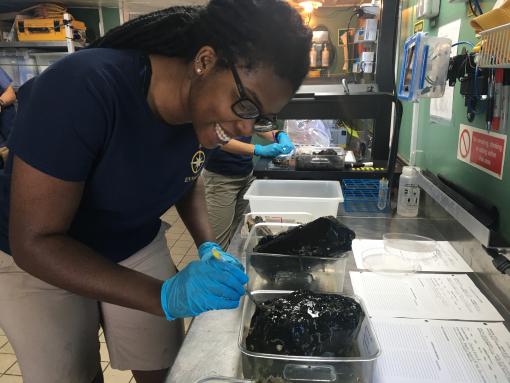What Happens After Cruises

Once an expedition ends, the collection of data and specimens live on in the laboratories of researchers, the archives of data centers, and the repositories of institutions. Although researchers on board and ashore sometimes recognize an exciting new discovery immediately, most discoveries will occur long after explorers return from sea. In addition, most deep-sea locations are unlikely to be revisited, further increasing the value of the data and specimens since they may remain the only information about a particular location for decades to come. As such, Ocean Exploration Trust (OET) preserves the priceless data, video, and samples gathered on expeditions in accordance with the highest standards to ensure it will be useful for decades to come.
ROV Data & Video
Scientists involved in the expedition, either on ship or shore, will continue to work on a portion of the data and samples, but there are many more discoveries to be made. As such, the video, data, and samples that result from our expeditions are available to any interested researcher immediately by request. Full datasets are sent to the Rolling Deck to Repository facility for long-term archival, visibility to researchers, and accessibility. Inclusion in well-known archives is critical as it is likely that researchers years from now will make discoveries from the standard datasets we collect on our expeditions. Starting in 2019, additional access to the satellite recordings of the ROV dives can be found on our Dive Recordings YouTube channel.

Moving Samples from Ship to Shore
So little is known about the inhabitants of the deep-sea that discoveries of new species or range extensions of organisms are quite common. Whole specimens and tissue sub-samples for DNA analysis have been housed at Harvard University’s Museum of Comparative Zoology since 2013. Samples are available to researchers by request.
Geological rocks and short sediment cores are processed onboard the ship and are available to researchers by request from the Marine Geological Samples Lab at the University of Rhode Island’s Graduate School of Oceanography.
Mapping the Gaps
Seafloor mapping data is available from the National Centers for Environmental Information. Mapping data is also contributed to global bathymetry archives such as the GEBCO project, Seabed 2030, which aims to produce a complete map of the seafloor by 2030. Much of our data is collected from remote places, which will otherwise go unmapped for years to come.

Documenting Results of Exploration
Finally, OET encourages explorers to generate knowledge from discoveries made with expedition data through peer-reviewed publications. It can take months for a researcher to recognize that a specimen is a new species and many years to formally write and publish a species description. Similarly, scientific work requires months to years of analysis, synthesis, and reduction to culminate in a publication. In order to raise awareness of the initial results of our cruises in a more timely way, OET works with expedition teams to write cruise summaries that are published annually in the Oceanography Society Magazine supplement: New Frontiers in Ocean Exploration. This is a great place to gain more information about our annual field programs. We continue to curate a growing list of manuscripts, books and book chapters, theses, and dissertations from the data and samples collected aboard Nautilus. We are proud of the time, care, and effort researchers put into ensuring exploration furthers our understanding of the planet. These discoveries can build momentum, leading to exciting avenues of research or the development of technologies to improve exploration capabilities.
